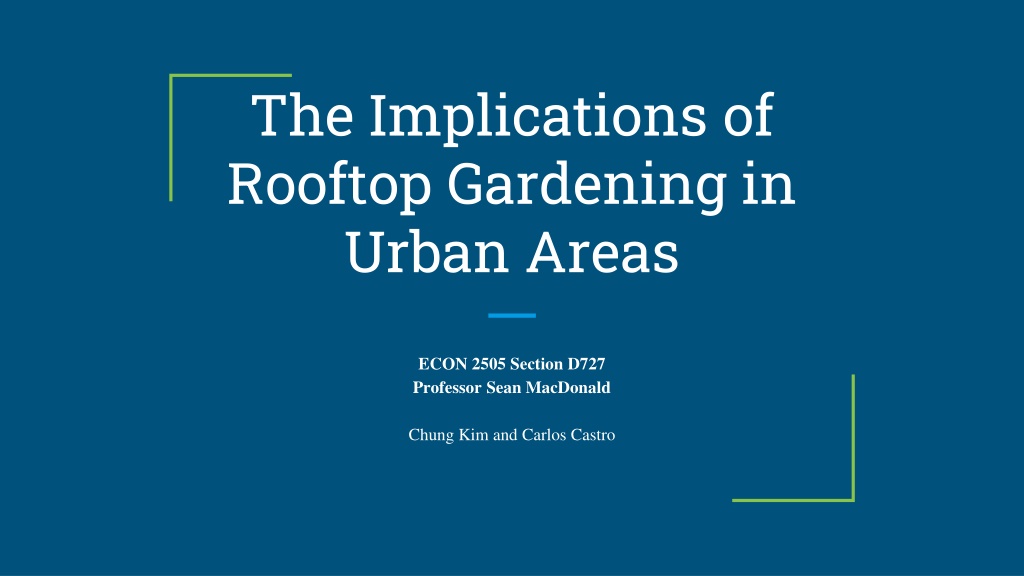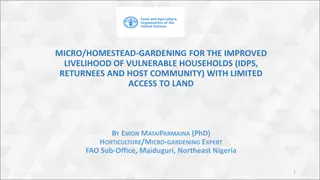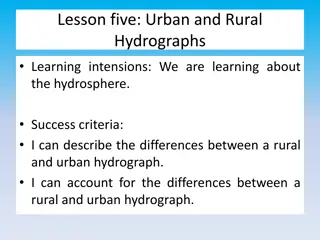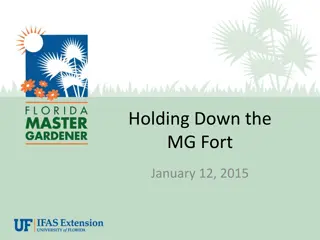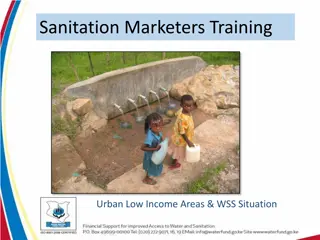The Impact of Rooftop Gardening in Urban Areas
Rooftop gardening in urban areas offers numerous benefits such as energy efficiency, climate control, stormwater management, and economic advantages. Companies like Gotham Greens have pioneered commercial-scale greenhouse farming on rooftops, providing high-quality produce while reducing environmental impact. However, there are potential dangers associated with consuming products from urban rooftop gardens due to contaminants like lead and arsenic in urban soils.
Download Presentation

Please find below an Image/Link to download the presentation.
The content on the website is provided AS IS for your information and personal use only. It may not be sold, licensed, or shared on other websites without obtaining consent from the author. Download presentation by click this link. If you encounter any issues during the download, it is possible that the publisher has removed the file from their server.
E N D
Presentation Transcript
The Implications of Rooftop Gardening in Urban Areas ECON 2505 Section D727 Professor Sean MacDonald Chung Kim and Carlos Castro
Gotham Greens Founders Eric haley Viraj Puri Jennifer Frymark
Gotham Green Located at 214 3rd St, Brooklyn, NY 11215. The nation s first commercial scale greenhouse farm. Started in 2010 and began distributing crops in 2011. Gotham Greens grows premium quality, pesticide-free produce in the 20,000 square foot greenhouse on the rooftop of Whole Foods Market Gowanus
Gotham Green They have supplied high-quality and fresh produce to Whole Foods Market and other local markets and restaurant Have 55 Kwatts of solar panel to provide energy in the facility Uses 10x less than conventional farming Eliminate the use of pesticides and fertilizer run-off - decreasing the global warming pollution Use organic non-GMO seeds Climate controlled facility can produce fresh products all year round
Benefits of Rooftop Gardenings 1.Energy 2.Climate 3.Stormwater Management 4.Economy
Climate Energy Reducing heat loss through wind chill in winter. The plants of green roof can capture airborne pollutants. Reduce carbon footprints - designed to reduce CO2. Less need for air conditioning in summer. Reduced the daily energy demand for air conditioning in the summer by over 75%. Reduce the Heat Island Effect.
Stormwater Management Economy Green roofs can retain rainwater. Buying farm goods from local rooftop gardens keep money within the local economy. Reduce the amount of stormwater runoff. Decrease stress on sewer systems at peak flow periods. Create jobs and increase employment
Potential Danger of Consuming products from Urban Rooftop Gardens Many urban growing areas are within 300 feet of high traffic areas Urbn soils can be present with lead, arsenic, and other toxins. Exposure to lead can cause organ damage, anemia, and a variety of neurological problems. Solutions: 1. Phytoremediation project - can help remove lead and other toxins that are presents in the soil. 2. Growing and consuming fruit-bearing plants that tend to contain lower lead concentrations.
Conclusion Advantages of rooftop gardens are many as compared to its disadvantages environmentally and economically. Food access is a social justice issue; it is a human rights issue. When urban communities lack access to affordable nutritious food, we must collectively help our fellow community members, and also educate and empower them to help themselves. Rooftop agriculture provides the canvas for food access assistance and empowerment in cities. Bearing in mind the benefits of the roof gardens, the cost factor may be looked at the least in order for roof gardens to be widely adopted. As long as people grow and consume products from the rooftop gardens with knowledge, it will give us enormous benefits maintaining a healthier lifestyle. Therefore, it is highly recommended for the government to play their role to facilitate this kind of innovation in a way to promote as well as to achieve sustainable development.
References Black, J. (2012). Rooftop Gardens. Fast Company. (167), 38. Garry, M. (2009). Rooftop Farm to Grow for Grocers. SN: Supermarket News, 57 (38), 21-27. Green, E. (2008). Urban Farming: Lead Problems and Remediation Solutions. 1-20. Liu, K. (2002). National Research Canada. Energy Efficiency and Environmental Benefits of Rooftop Gardens, 44 (2), 20-23. Miller, M. (2014). National Geographic. A Farm Grows In Brooklyn. From http://news.nationalgeographic.com/news/2014/04/140429-farming- rooftop-gardening- brooklyn- grange-vegetables- science-food/. GSA. (2011). The Benefits and Challenges of Green Roofs on Public and Commercial Buildings, p. 59-62.
